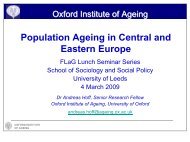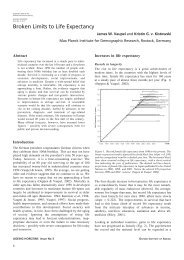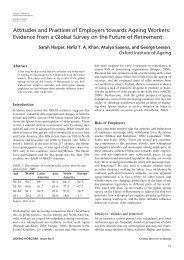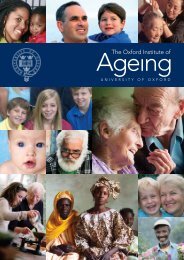Blueprint - October 2011 - Oxford Institute of Ageing - University of ...
Blueprint - October 2011 - Oxford Institute of Ageing - University of ...
Blueprint - October 2011 - Oxford Institute of Ageing - University of ...
Create successful ePaper yourself
Turn your PDF publications into a flip-book with our unique Google optimized e-Paper software.
<strong>October</strong> <strong>2011</strong> BLUEPRINT 9<br />
game <strong>of</strong> spot-the-difference: developing<br />
s<strong>of</strong>tware that automates the process <strong>of</strong><br />
spotting the mistakes. By scanning frames <strong>of</strong><br />
a movie that should theoretically contain objects<br />
in the same physical locations, the team<br />
can detect subtle differences – a job previously<br />
left for over-enthusiastic film fans.<br />
While that is pro<strong>of</strong> that finding objects<br />
within footage is possible, video search also<br />
needs to be able to identify humans – an<br />
altogether tougher task. Changing facial<br />
expression, differing hair styles and constant<br />
movement make actors extremely difficult<br />
for computers to identify. By using cuttingedge<br />
facial recognition, though, Dr Mark<br />
Everingham, working in Zisserman’s team,<br />
can identify the eyes, nose and mouth, using<br />
distinctive features around these areas to<br />
reliably spot faces time and again. Indeed, by<br />
following the detected face between frames,<br />
it is possible to track actors as they move<br />
around a set, and even automatically assign<br />
the correct character name to each face<br />
through space and time.<br />
Unsurprisingly, this is making a big impression<br />
commercially as it allows video content<br />
to be labelled and searched automatically.<br />
‘At VideoSurf, we run a scaleable video<br />
search engine. We do for video what Google<br />
does for text,’ explains Eitan Sharon, Chief<br />
Technology Officer and co-founder <strong>of</strong><br />
VideoSurf. ‘We’ve developed a smartphone<br />
app that lets you point your phone at any<br />
screen – even live TV – and in a few seconds<br />
it can tell you what the video is, who’s in it,<br />
even recommend other videos you might<br />
like.’ All <strong>of</strong> this takes its cue from <strong>University</strong><br />
<strong>of</strong> <strong>Oxford</strong> research. ‘Andrew Zisserman has<br />
really left his mark on computer vision over<br />
the last decade,’ he adds. ‘He’s changed the<br />
way we think about and tackle video, and<br />
shaped what we do.’<br />
If those changes already seem pr<strong>of</strong>ound,<br />
they look set to get even bigger in the<br />
future. Elsewhere in the department, efforts<br />
are being made not just to identify who<br />
appears on film - but what they are doing,<br />
too. ‘We were doing some work looking at<br />
surveillance footage,’ says Pr<strong>of</strong>essor Ian Reid,<br />
‘and we were trying to understand what<br />
people were doing. But when we looked at a<br />
lot <strong>of</strong> this footage, we realised that humans<br />
were very good at being able to tell if two<br />
people were interacting just by looking at<br />
how they turned their heads to each other.<br />
We realised there was the potential to use<br />
computer vision techniques to work out<br />
where people were looking, even in very low<br />
resolution images, and that this could give<br />
strong clues as to what was going on.’<br />
So that’s just what they did. The first step<br />
was to detect the presence <strong>of</strong> humans in<br />
CCTV footage, which uses similar techniques<br />
to Zisserman’s face recognition, combined<br />
with detection <strong>of</strong> the geometry <strong>of</strong> the<br />
human body. That allows the team to single<br />
out individuals in crowds and follow them<br />
as they move. It is then possible to isolate<br />
footage <strong>of</strong> just the head and use these<br />
images to work out where a particular<br />
person is looking. By training s<strong>of</strong>tware to<br />
recognise which head orientations are related<br />
to certain fields <strong>of</strong> vision – if, for instance,<br />
you can only see the back <strong>of</strong> a person’s<br />
head, they must be looking in the opposite<br />
direction – the s<strong>of</strong>tware can indicate where<br />
each person is looking, giving a feel for how<br />
the attention <strong>of</strong> entire crowds is drawn.<br />
‘If something interesting is happening,<br />
you might actually be more likely to detect<br />
people looking at it rather than detecting<br />
the original incident itself,’ explains Reid.<br />
‘We’re looking at the “abandoned bag”<br />
scenario. Usually, people try to detect the<br />
bag itself, or the presence <strong>of</strong> something<br />
that didn’t used to be there, but neither<br />
<strong>of</strong> those work particularly well in crowded<br />
environments. But as people walk past a bag<br />
in, say, the Underground, they tend to look<br />
at it – that’s what we’re trying to detect.’<br />
By creating maps <strong>of</strong> attention, which show<br />
where groups <strong>of</strong> people focus their gaze,<br />
the team has developed s<strong>of</strong>tware capable<br />
<strong>of</strong> identifying small, subtle changes in<br />
crowded environments.<br />
As well as picking out behaviour across<br />
crowds, a person’s gaze can help analyse<br />
more intimate interactions, too – which<br />
is where Zisserman and Reid’s work<br />
collides. Zisserman’s team has been working<br />
on identifying actions – such as drinking, or<br />
using a telephone – for some time, but the<br />
stumbling block has long been actions that<br />
involve two people. Now, Dr Alonso Patron-<br />
Perez has included aspects <strong>of</strong> Reid’s research.<br />
When two people interact – maybe kissing,<br />
or giving a high-five – their gaze tends to be<br />
focused in the direction <strong>of</strong> the other person,<br />
and that was the final piece <strong>of</strong> the puzzle<br />
required to accurately detect interactions<br />
between humans. That not only allows the<br />
video search <strong>of</strong> Zisserman’s dreams to identify<br />
anything from a hairbrush to a heart-felt<br />
hug, but also means that CCTV footage can<br />
be analysed to determine criminal behaviour.<br />
All told, it is no surprise that the researchers<br />
are now working with the organisers,<br />
ranging from national television companies<br />
who want to analyse their archived footage,<br />
to governmental security agencies<br />
needing cutting-edge surveillance<br />
technology. Whichever way you look at it,<br />
these engineers certainly seem to have<br />
earned their place on the A-list.<br />
From top:<br />
Willow<br />
Buffy<br />
Characters can be automatically labelled,<br />
as here in Buffy the Vampire Slayer;<br />
Analysing scenes like this ‘high-five’ in How<br />
I Met your Mother created a breakthrough<br />
in detecting human interactions;<br />
Tracking objects like the picture behind<br />
Audrey Hepburn in Charade can eliminate<br />
continuity errors;<br />
Individuals on CCTV footage (here on<br />
Cornmarket St in <strong>Oxford</strong>) can be singled<br />
out and tracked<br />
‘Just imagine: you could see<br />
someone on TV, click on their<br />
face and instantly find out<br />
what else they’ve appeared in –<br />
that’s what I set out to do’<br />
– Pr<strong>of</strong>essor Andrew Zisserman<br />
For further information and<br />
demonstration videos, see<br />
www.robots.ox.ac.uk/~vgg/ and<br />
www.robots.ox.ac.uk/ActiveVision/


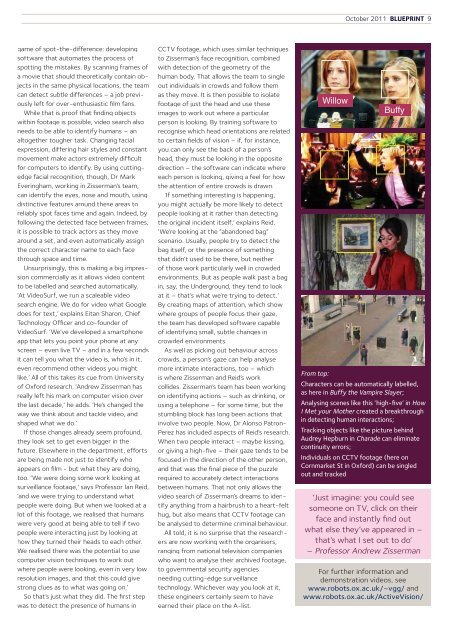

![ORAL PRESENTATIONS [pdf] - Oxford Institute of Ageing](https://img.yumpu.com/37918222/1/184x260/oral-presentations-pdf-oxford-institute-of-ageing.jpg?quality=85)

